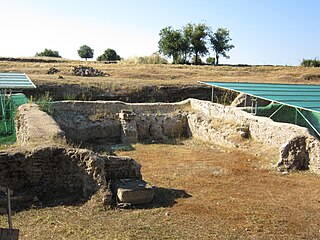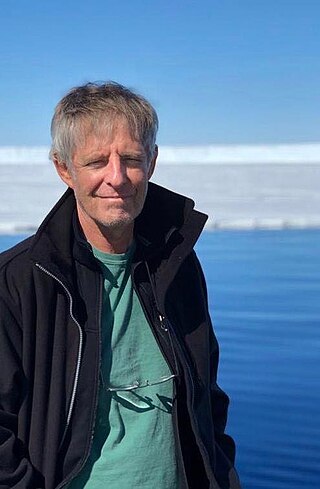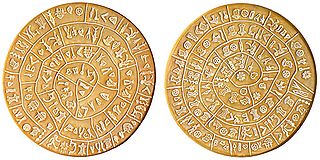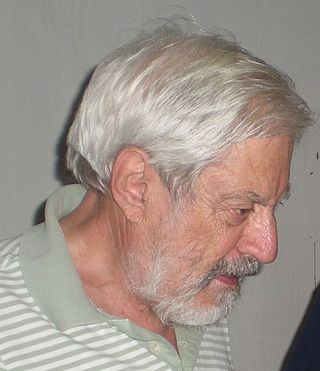Related Research Articles

Volterra is a walled mountaintop town in the Tuscany region of Italy. Its history dates from before the 8th century BC and it has substantial structures from the Etruscan, Roman, and Medieval periods.
Mauro Cristofani was a linguist and researcher in Etruscan studies.

Gabii was an ancient city of Latium, located 18 km (11 mi) due east of Rome along the Via Praenestina, which was in early times known as the Via Gabina. It was on the south-eastern perimeter of an extinct volcanic crater lake, approximately circular in shape, named the Lacus Gabinus, and then during later times called the Lago di Castiglione, "lake of the fortification", after Castiglione, a mediaeval tower erected on the site of the ancient acropolis, or arx, of Gabii. A necropolis is adjacent on that side of the lake. At present, the former lake is entirely agricultural land. The ruins of the ancient city project from the fields next to the cliffs overlooking it, on both sides of the via. A municipium in Roman times, Gabii is currently located in the frazione of Osteria dell'Osa 10 km (6.2 mi) from the comune of Monte Compatri, of which it is a part, in the Province of Rome, Region of Lazio. The site is under new seasonal archaeological excavation.

Andrea Carandini is an Italian professor of archaeology specialising in ancient Rome. Among his many excavations is the villa of Settefinestre.
Frank Edward Brown was a preeminent Mediterranean archaeologist.

Satricum, an ancient town of Latium vetus, lay on the right bank of the Astura river some 60 kilometres (37 mi) SE of Rome in a low-lying region south of the Alban Hills, at the NW border of the Pontine Marshes. It was directly accessible from Rome via a road running roughly parallel to the Via Appia.
Mario Torelli was an Italian scholar of Italic archaeology and the culture of the Etruscans. He taught at the University of Perugia.

Massimo Pallottino was an Italian archaeologist specializing in Etruscan civilization and art.
Giulio Quirino Giglioli was an art historian of classical Roman and Etruscan art and was associated with Fascism in Italy.
Clementina Panella is an Italian archaeologist, a professor at the University of Rome La Sapienza, where she teaches Methodology of Archaeology. She has guided and co-written a number of articles on the commercial pottery of ancient Italy.

Mensun Bound is a British maritime archaeologist born in Stanley, Falkland Islands. He is best known as director of exploration for two expeditions to the Weddell Sea which led to the rediscovery of the Endurance, in which Sir Ernest Shackleton and a crew of 27 men sailed for the Antarctic on the 1914–1917 Imperial Trans-Antarctic Expedition. The ship sank after being crushed by the ice on 21 November 1915. It was rediscovered by the Endurance22 expedition on 5 March 2022.

The Swedish Institute in Rome is a research institution that serves as the base for archaeological excavations and other scientific research in Italy. It also pursues academic instruction in archaeology and art sciences as well as arranging conferences with themes of interest to the institute. The institute has at its disposal a building in central Rome, designed by Ivar Tengbom, with a relatively well-supplied library, archaeological laboratory and around twenty rooms and smaller apartments for the use of visiting researchers and holders of scholarships.

Alessandra Melucco Vaccaro was an Italian historian and archaeologist. Her main activity was in the three fields in which she made significant innovations - the High Middle Ages, archaeological restoration, and environment and landscape. President Carlo Azeglio Ciampi conferred the Medaglia d'Oro for culture and art in Vaccaro's memory in February 2001.

Luigi Pernier was an Italian archaeologist and academic now best known for his discovery of the Disc of Phaistos.
Elizabeth Barringer Fentress is a Roman archaeologist who specialises in Italy and North Africa. She has collaborated on the excavation of numerous sites in the Western Mediterranean and published their results. She is also the originator and scientific director of the online database of excavations in Italy, Bulgaria and elsewhere Fasti Online (www.fastionline.org), and editor of its journal Fasti Online Documents & Research (FOLD&R). In 2021 she was awarded the Archaeological Institute of America's 2022 gold medal for distinguished archaeological achievement.
The archaeological area of Poggio del Molino is situated on the northern side of a headland that acts as a watershed between the beach of Rimigliano in the north, and the Gulf of Baratti in the south; to the northern border of the territory administered by the city of Piombino in the Italian Province of Livorno. The structure of Roman age spreads over a high plateau of about 20 m asl which dominates, in the west, the stretch of a sea between San Vincenzo and Elba and to the east, the metalliferous hills and plains of the Campiglia lagoon. The top of the hill is occupied by the beautiful Villa del Barone, built in 1923 by Baron Luigi De Stefano and Assunta Vanni Desideri, the daughter of Eugenio. From a paper of the 16th century, the "Bandita di Porto Baratti", and some archival documents we know that the Poggio owes its name to the mill which was a part of Torre Nuova, the building of coastal defense and a lookout built in the early sixteenth century by Cosimo I de' Medici, on the slopes of the promontory.
Robert Ross Holloway was an American archaeologist, founder of the independent center for Mediterranean archaeology at Brown University, and the Elisha Benjamin Andrews Professor Emeritus of Brown University, where he taught from 1964 to his retirement in 2006.

Italo Insolera was an Italian architect, urban and land planner, and historian.

The Roman theatre of Volterra was discovered in the 1950s, during archaeological excavations of the ancient Roman city conducted by Enrico Fiumi. It is one of the best-preserved Roman theatres in Italy. It is located just outside the Porta Fiorentina, in an area called Vallebuona.
References
- ↑ "Nic Terrenato". nicterrenato.academia.edu. Retrieved 2018-03-31.
- ↑ "Acknowledgements | Gabii Project". sites.lsa.umich.edu. Retrieved 2018-03-31.